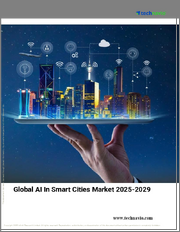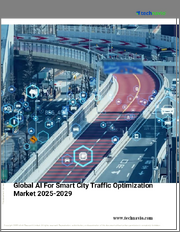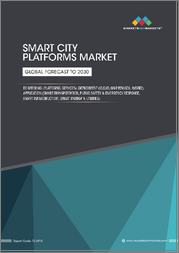
|
시장보고서
상품코드
1538584
세계의 스마트 시티 시장 규모 조사 : 솔루션별, 지역별 예측(2022-2032년)Global Smart Cities Market Size Study, by Solution (Smart Mobility Management, Smart Public Safety, Smart Healthcare, Smart Building, Smart Utilities, Smart Security, Smart Education, Other Solutions) and Regional Forecasts 2022-2032 |
||||||
세계의 스마트 시티 시장은 2023년에 약 5,491억 달러로 평가되며, 예측 기간인 2024-2032년에는 15.2% 이상의 건전한 성장률로 성장할 것으로 예측됩니다.
스마트 시티는 전자적 방법과 센서를 통해 데이터를 수집하고 이를 활용해 자산, 자원, 서비스를 효율적으로 관리하는 첨단 도시를 말합니다. 이러한 종합적인 접근 방식은 도시 운영을 간소화하는 동시에 시민의 삶의 질을 향상시킵니다. 환경 지속가능성에 대한 관심이 높아지면서 스마트 시티 기술 채택을 촉진하고 효율적인 자원 관리와 환경 모니터링을 보장함으로써 시장 성장에 영향을 미치고 있습니다.
세계 스마트 시티 시장은 몇 가지 중요한 요인으로 인해 강력한 성장을 보이고 있습니다. 비디오 감시, 실시간 번호판 추적, 얼굴 인식과 같은 기술 혁신을 통한 치안 강화는 중요한 촉진요인입니다. 스마트 시티 솔루션은 도시의 다양한 출처의 데이터를 통합하여 교통안전, 데이터베이스 단속, 최적화된 비상 대응 등을 강화함으로써 초기 대응자에게 보다 안전한 환경을 제공합니다. 맥킨지 보고서에 따르면 스마트 시티는 구급대원의 도착 시간을 앞당겨 범죄 발생률을 30-40% 감소시킬 수 있다고 합니다. 하지만 스마트 시티 솔루션을 도입하려면 분석, 설계, 코딩, 문서화 등에 많은 투자가 필요하므로 높은 비용이 큰 걸림돌로 작용하고 있습니다. 예산의 제약으로 인해 많은 경제권에서 이러한 첨단 시스템을 도입하지 못하고 있으며, 이는 시장 성장을 저해하고 있습니다. 반면, 5G 기술의 등장은 클라우드 컴퓨팅을 혁신하고 빠른 통신과 데이터 전송을 가능하게 하는 큰 기회이며, 5G가 촉진하는 고속 및 저지연 연결은 공공 안전 강화에서 AI 및 센서 통합을 통한 도시 관리 최적화까지 다양한 용도를 지원할 수 있습니다. 지원합니다.
세계 스마트 시티 시장 조사에서 고려된 주요 지역으로는 아시아태평양, 북미, 유럽, 중남미, 기타 유럽이 포함됩니다. 북미는 미국과 캐나다의 스마트 시티 기술 도입이 활발히 진행되면서 예측 기간 중 가장 큰 시장 규모를 유지할 것으로 예상됩니다. 이들 국가는 연구개발(R&D)에 많은 투자를 할 수 있는 강력한 경제력을 바탕으로 혁신적인 기술 발전을 촉진하고 있습니다. 북미의 네트워크 사업자들은 특히 5G 네트워크로의 전환을 통해 통신 인프라를 지속적으로 강화하고 있으며, 이는 스마트 시티 솔루션의 광범위한 채택을 지원하고 있습니다. 한편, 아시아태평양 시장은 급속한 도시화, 인구 밀도 증가, 지속가능하고 효율적인 도시 관리의 필요성에 힘입어 예측 기간 중 가장 빠른 속도로 성장할 것으로 예상됩니다. 이 지역 정부들은 교통 체증, 오염, 자원 부족 등의 문제를 해결하기 위해 스마트 시티 인프라 개발에 많은 투자를 하고 있습니다. 또한 IoT, AI, 빅데이터 기술 채택이 확대되면서 이 시장의 성장을 가속화하고 있습니다.
목차
제1장 세계의 스마트 시티 시장 개요
- 세계의 스마트 시티 시장 규모·예측(2022-2032년)
- 지역별 개요
- 부문별 개요
- 솔루션별
- 주요 동향
- 불황의 영향
- 애널리스트 결론·제안
제2장 세계의 스마트 시티 시장 정의와 조사 전제조건
- 조사 목적
- 시장의 정의
- 조사 전제조건
- 포함과 제외
- 제한 사항
- 공급측 분석
- 가용성
- 인프라
- 규제 환경
- 시장 경쟁
- 경제성(소비자의 시점)
- 수요측 분석
- 규제 프레임워크
- 기술의 진보
- 친환경
- 소비자의 의식과 수용
- 조사 방법
- 조사 대상년
- 통화 환산율
제3장 세계의 스마트 시티 시장 역학
- 시장 성장 촉진요인
- 기술 혁신에 의한 스마트 시티에서 공공안전의 강화
- 도시화의 진전이 스마트 시티 솔루션의 채택을 촉진
- 시장이 해결해야 할 과제
- 높은 도입 비용
- IoT와 스마트 디바이스에 관한 보안상 우려
- 시장 기회
- 5G의 부상
- AI와 IoT의 급속한 보급
제4장 세계의 스마트 시티 시장 산업 분석
- Porter's Five Forces 모델
- 공급 기업의 교섭력
- 바이어의 교섭력
- 신규 진출업체의 위협
- 대체품의 위협
- 경쟁 기업 간 경쟁 관계
- Porter's Five Forces 모델에 대한 미래적 어프로치
- Porter's Five Forces의 영향 분석
- PESTEL 분석
- 정치
- 경제
- 사회
- 기술
- 환경
- 법률
- 주요 투자 기회
- 주요 성공 전략
- 파괴적 동향
- 업계 전문가의 시점
- 애널리스트 결론·제안
제5장 세계의 스마트 시티 시장 규모와 예측 : 솔루션별, 2022-2032년
- 부문 대시보드
- 세계의 스마트 시티 시장 : 매출 동향 분석, 2022년·2032년
- 스마트 모빌리티 관리
- 스마트 공공안전
- 스마트 헬스케어
- 스마트 빌딩
- 스마트 유틸리티
- 스마트 보안
- 스마트 교육
- 기타 솔루션
제6장 세계의 스마트 시티 시장 규모와 예측 : 지역별, 2022-2032년
- 북미
- 미국
- 캐나다
- 유럽
- 영국
- 독일
- 프랑스
- 스페인
- 이탈리아
- 기타 유럽
- 아시아태평양
- 중국
- 인도
- 일본
- 호주
- 한국
- 기타 아시아태평양
- 라틴아메리카
- 브라질
- 멕시코
- 기타 라틴아메리카
- 중동 및 아프리카
- 사우디아라비아
- 남아프리카공화국
- 기타 중동 및 아프리카
제7장 경쟁 정보
- 주요 기업의 SWOT 분석
- 주요 시장 전략
- 기업 개요
- Cisco(US)
- 주요 정보
- 개요
- 재무(데이터의 가용성에 따름)
- 제품 개요
- 시장 전략
- IBM(US)
- Siemens(Germany)
- Microsoft(US)
- Hitachi(Japan)
- Schneider Electric(France)
- Huawei(China)
- Intel(US)
- NEC(Japan)
- ABB(Switzerland)
- Ericsson(Sweden)
- Oracle(US)
- Fujitsu(Japan)
- Honeywell(US)
- Accenture(Ireland)
- Cisco(US)
제8장 조사 프로세스
- 조사 프로세스
- 데이터 마이닝
- 분석
- 시장 추정
- 검증
- 출판
- 조사 속성
Global Smart Cities Market is valued approximately at USD 549.1 billion in 2023 and is anticipated to grow with a healthy growth rate of more than 15.2% over the forecast period 2024-2032. A smart city is an advanced urban area that employs electronic methods and sensors to collect data, which is then used to manage assets, resources, and services efficiently. This holistic approach enhances the quality of life for citizens while streamlining city operations. Rising environmental sustainability concerns drive the adoption of smart city technologies, influencing market growth by ensuring efficient resource management and environmental monitoring.
Global Smart Cities Market is experiencing robust growth driven by several key factors. Enhancing public safety through technological innovations, such as video surveillance, real-time license plate tracking, and facial recognition, is a significant driver. Smart city solutions aggregate data from diverse urban sources to enhance traffic safety, data-driven policing, and optimized emergency responses, thereby ensuring safer conditions for first responders. McKinsey reports that smart cities could potentially reduce crime rates by 30-40% through expedited first responder arrival times. However, the high cost of implementing smart city solutions, which involves significant investments in analytics, design, coding, and documentation, poses a substantial challenge. Tight budget constraints prevent many economies from deploying these advanced systems, hindering market growth. On the other hand, the rise of 5G technology presents a significant opportunity, transforming cloud computing and enabling rapid communication and data transfer. The high-speed, low-latency connectivity facilitated by 5G supports various applications, from enhancing public safety to optimizing city management through AI and sensor integration.
The key regions considered for the global Smart Cities Market study include Asia Pacific, North America, Europe, Latin America, and Rest of the World. North America is expected to hold the largest market size during the forecast period, driven by the robust adoption of smart city technologies in the United States and Canada. These countries benefit from strong economies that enable substantial investments in research and development, fostering the advancement of innovative technologies. Network operators in North America are also consistently enhancing their telecommunications infrastructure, particularly through the transition to 5G networks, which supports the widespread adoption of smart city solutions. Whereas, the market in Asia Pacific is anticipated to grow at the fastest rate over the forecast period fueled by rapid urbanization, increasing population density, and the need for sustainable and efficient urban management. Governments in the region are investing heavily in developing smart city infrastructure to address challenges such as traffic congestion, pollution, and resource scarcity. Additionally, the growing adoption of IoT, AI, and big data technologies is accelerating the growth of this market.
Major market players included in this report are:
- Cisco (US)
- IBM (US)
- Siemens (Germany)
- Microsoft (US)
- Hitachi (Japan)
- Schneider Electric (France)
- Huawei (China)
- Intel (US)
- NEC (Japan)
- ABB (Switzerland)
- Ericsson (Sweden)
- Oracle (US)
- Fujitsu (Japan)
- Honeywell (US)
- Accenture (Ireland)
The detailed segments and sub-segment of the market are explained below:
By Solution:
- Smart Mobility Management
- Smart Public Safety
- Smart Healthcare
- Smart Building
- Smart Utilities
- Smart Security
- Smart Education
- Other Solutions
By Region:
- North America
- U.S.
- Canada
- Europe
- UK
- Germany
- France
- Spain
- Italy
- ROE
- Asia Pacific
- China
- India
- Japan
- Australia
- South Korea
- RoAPAC
- Latin America
- Brazil
- Mexico
- RoLA
- Middle East & Africa
- Saudi Arabia
- South Africa
- RoMEA
Years considered for the study are as follows:
- Historical year - 2022
- Base year - 2023
- Forecast period - 2024 to 2032
Key Takeaways:
- Market Estimates & Forecast for 10 years from 2022 to 2032.
- Annualized revenues and regional level analysis for each market segment.
- Detailed analysis of geographical landscape with Country level analysis of major regions.
- Competitive landscape with information on major players in the market.
- Analysis of key business strategies and recommendations on future market approach.
- Analysis of competitive structure of the market.
- Demand side and supply side analysis of the market.
Table of Contents
Chapter 1. Global Smart Cities Market Executive Summary
- 1.1. Global Smart Cities Market Size & Forecast (2022- 2032)
- 1.2. Regional Summary
- 1.3. Segmental Summary
- 1.3.1. By Solution
- 1.4. Key Trends
- 1.5. Recession Impact
- 1.6. Analyst Recommendation & Conclusion
Chapter 2. Global Smart Cities Market Definition and Research Assumptions
- 2.1. Research Objective
- 2.2. Market Definition
- 2.3. Research Assumptions
- 2.3.1. Inclusion & Exclusion
- 2.3.2. Limitations
- 2.3.3. Supply Side Analysis
- 2.3.3.1. Availability
- 2.3.3.2. Infrastructure
- 2.3.3.3. Regulatory Environment
- 2.3.3.4. Market Competition
- 2.3.3.5. Economic Viability (Consumer's Perspective)
- 2.3.4. Demand Side Analysis
- 2.3.4.1. Regulatory frameworks
- 2.3.4.2. Technological Advancements
- 2.3.4.3. Environmental Considerations
- 2.3.4.4. Consumer Awareness & Acceptance
- 2.4. Estimation Methodology
- 2.5. Years Considered for the Study
- 2.6. Currency Conversion Rates
Chapter 3. Global Smart Cities Market Dynamics
- 3.1. Market Drivers
- 3.1.1. Enhancing Public Safety in Smart Cities Through Technological Innovation
- 3.1.2. Growth in urbanization to drive adoption of smart city solutions
- 3.2. Market Challenges
- 3.2.1. High cost of implementation
- 3.2.2. Security Concerns Related to IoT and Smart Devices
- 3.3. Market Opportunities
- 3.3.1. Rise of 5G
- 3.3.2. Surging Adoption of AI and IoT
Chapter 4. Global Smart Cities Market Industry Analysis
- 4.1. Porter's 5 Force Model
- 4.1.1. Bargaining Power of Suppliers
- 4.1.2. Bargaining Power of Buyers
- 4.1.3. Threat of New Entrants
- 4.1.4. Threat of Substitutes
- 4.1.5. Competitive Rivalry
- 4.1.6. Futuristic Approach to Porter's 5 Force Model
- 4.1.7. Porter's 5 Force Impact Analysis
- 4.2. PESTEL Analysis
- 4.2.1. Political
- 4.2.2. Economical
- 4.2.3. Social
- 4.2.4. Technological
- 4.2.5. Environmental
- 4.2.6. Legal
- 4.3. Top investment opportunity
- 4.4. Top winning strategies
- 4.5. Disruptive Trends
- 4.6. Industry Expert Perspective
- 4.7. Analyst Recommendation & Conclusion
Chapter 5. Global Smart Cities Market Size & Forecasts by Solution 2022-2032
- 5.1. Segment Dashboard
- 5.2. Global Smart Cities Market: Solution Revenue Trend Analysis, 2022 & 2032 (USD Billion)
- 5.2.1. Smart Mobility Management
- 5.2.2. Smart Public Safety
- 5.2.3. Smart Healthcare
- 5.2.4. Smart Building
- 5.2.5. Smart Utilities
- 5.2.6. Smart Security
- 5.2.7. Smart Education
- 5.2.8. Other Solutions
Chapter 6. Global Smart Cities Market Size & Forecasts by Region 2022-2032
- 6.1. North America Smart Cities Market
- 6.1.1. U.S. Smart Cities Market
- 6.1.1.1. Solution breakdown size & forecasts, 2022-2032
- 6.1.2. Canada Smart Cities Market
- 6.1.1. U.S. Smart Cities Market
- 6.2. Europe Smart Cities Market
- 6.2.1. U.K. Smart Cities Market
- 6.2.2. Germany Smart Cities Market
- 6.2.3. France Smart Cities Market
- 6.2.4. Spain Smart Cities Market
- 6.2.5. Italy Smart Cities Market
- 6.2.6. Rest of Europe Smart Cities Market
- 6.3. Asia-Pacific Smart Cities Market
- 6.3.1. China Smart Cities Market
- 6.3.2. India Smart Cities Market
- 6.3.3. Japan Smart Cities Market
- 6.3.4. Australia Smart Cities Market
- 6.3.5. South Korea Smart Cities Market
- 6.3.6. Rest of Asia Pacific Smart Cities Market
- 6.4. Latin America Smart Cities Market
- 6.4.1. Brazil Smart Cities Market
- 6.4.2. Mexico Smart Cities Market
- 6.4.3. Rest of Latin America Smart Cities Market
- 6.5. Middle East & Africa Smart Cities Market
- 6.5.1. Saudi Arabia Smart Cities Market
- 6.5.2. South Africa Smart Cities Market
- 6.5.3. Rest of Middle East & Africa Smart Cities Market
Chapter 7. Competitive Intelligence
- 7.1. Key Company SWOT Analysis
- 7.2. Top Market Strategies
- 7.3. Company Profiles
- 7.3.1. Cisco (US)
- 7.3.1.1. Key Information
- 7.3.1.2. Overview
- 7.3.1.3. Financial (Subject to Data Availability)
- 7.3.1.4. Product Summary
- 7.3.1.5. Market Strategies
- 7.3.2. IBM (US)
- 7.3.3. Siemens (Germany)
- 7.3.4. Microsoft (US)
- 7.3.5. Hitachi (Japan)
- 7.3.6. Schneider Electric (France)
- 7.3.7. Huawei (China)
- 7.3.8. Intel (US)
- 7.3.9. NEC (Japan)
- 7.3.10. ABB (Switzerland)
- 7.3.11. Ericsson (Sweden)
- 7.3.12. Oracle (US)
- 7.3.13. Fujitsu (Japan)
- 7.3.14. Honeywell (US)
- 7.3.15. Accenture (Ireland)
- 7.3.1. Cisco (US)
Chapter 8. Research Process
- 8.1. Research Process
- 8.1.1. Data Mining
- 8.1.2. Analysis
- 8.1.3. Market Estimation
- 8.1.4. Validation
- 8.1.5. Publishing
- 8.2. Research Attributes



















